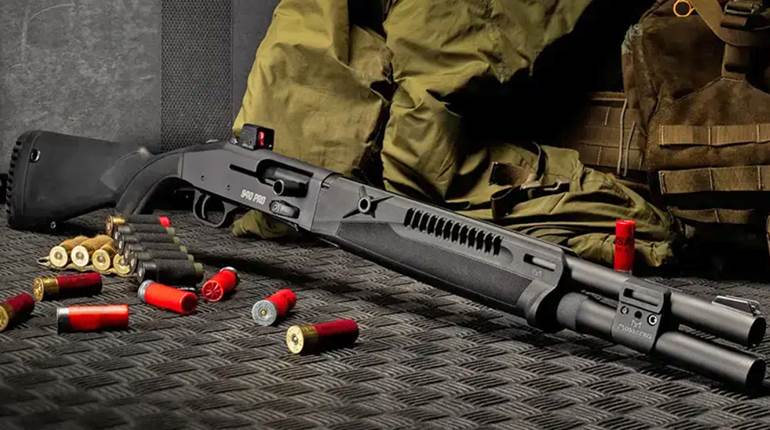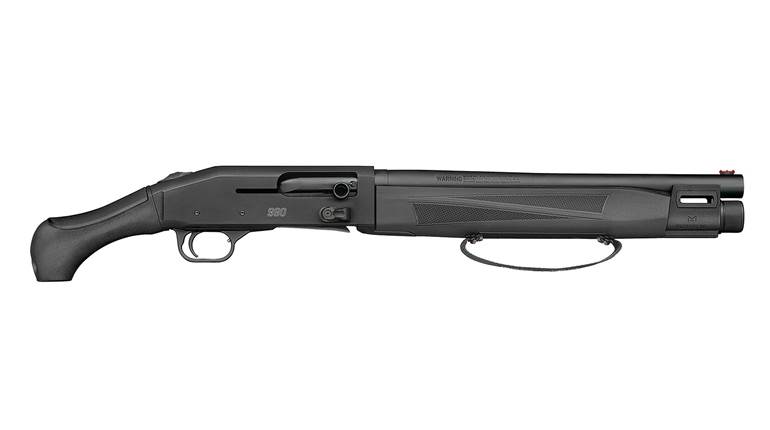
The concept of an all-purpose rifle is not a new one. Since the early days in America our frontiersmen and women expected the rifle in their hands to deal with whatever task might be before them. Because they might have to collect meat for the table, dispatch varmints, or deal with the two-legged varmints that often made life troublesome, the pioneers seldom had racks of rifles designed for specific shooting chores. One rifle was expected to do it all.
In more modern times, Col. Jeff Cooper designed a similar rifle.
His Scout Rifle concept was designed to fill most hunting needs and still provide protection for the armed citizen.
Cooper experimented with several bolt-action rifles and finally settled on one with a short overall length, a forward-mounted scope and chambered for the .308 Win. cartridge.
I like the whole concept of the multi-purpose rifle and prefer to call them “Utility Rifles.” All of which brings us to the MVP line of rifles from Mossberg. Essentially, Mossberg redesigned its bolt-action rifle so that it would function using AR magazines to allow for greater magazine capacity. However, instead of coming up with a single rifle design, Mossberg built a family of guns around two patent-pending bolt designs that allow 7.62mm NATO (308 Win) chambered rifles to accept both M1A/M14 AND AR10-style magazines and 5.56mm NATO (223 Rem) rifles to accept AR15-style magazines.
The “drop-push” bolt in 5.56x45 mm NATO (.223 Rem.) and .204 Ruger features a spring-loaded lip at the bottom of its face. As the bolt is pushed forward, the lip drops to catch a cartridge from the top of the staggered-box magazine and push it forward into the chamber. As the bolt is withdrawn, the lip is pushed upward and overrides the next cartridge.
On the 7.62x51 mm NATO (.308 Win.) versions of the MVP rifle, the bolt has two small projections at the bottom of its face that perform the same function, engaging a cartridge regardless of which side of the staggered magazine it happens to be on.
The MVP features a plunger-style ejector in the bolt face and a sliding-plate extractor in the bolt’s right lug. The bolt itself is fluted to reduce friction and gives the rifle a bit of a custom look.
Mossberg’s MVP rifles utilize the company’s Adjustable Trigger System, and it is much like those seen on other brands of rifles. With the barreled action removed from the stock, the trigger can be easily adjusted down to a 2-lb. pull. The MVP Patrol that I tested came out of the box with the trigger pull adjusted to slightly more than 3 lbs., which is about right for most hunting chores. However, especially for varmint shooting, the 2-lb. setting is appealing.
Barrels on the MVP series are marked with military designations (5.56 mm and 7.62 mm) instead of the more common .223 Rem. and .308 Win.. This is due to the fact that military chamber and throat specs are slightly larger than commercial chamberings. Military ammunition fired in rifles of commercial chamberings can cause slightly higher pressures. This is rarely a problem, but Mossberg took the precaution so that both military and commercial ammunition can be fired in its rifles without a hitch. 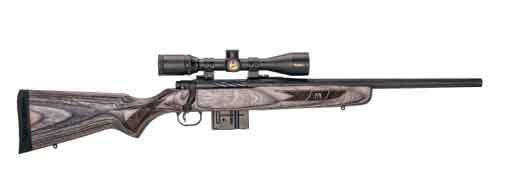
The Mossberg MVP Predator is available in either 5.56 mm NATO (.223 Rem.) or 7.62 mm NATO (.308 Win.). It comes with either an 18.5" fluted, medium bull barrel, or a 20" fluted sporter barrel that is also threaded at the muzzle. Weaver-style scope bases are attached, and there are no iron sights on the rifle. The stock is an attractive laminated wood with sling-swivel studs attached. Weight for either barrel length and caliber runs right at 7 lbs.
The MVP Flex is also offered in both 5.56 mm and 7.62 mm. On the Flex, the stock is synthetic and the buttstock is the collapsible tubular configuration that is found on most ARs. Of course, all of the various buttstocks within the Mossberg Flex system will fit on this rifle, and they can be swapped out in minutes without tools. There are no iron sights on this model, and it has a Picatinny rail for the mounting of optics. 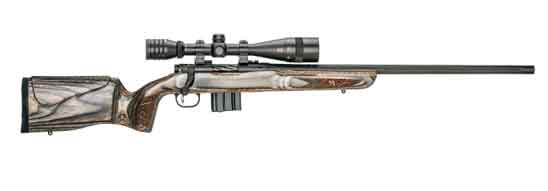
The MVP Varmint sports a 24" fluted, medium bull barrel, and it is available in 5.56 mm, 7.62 mm, or .204 Ruger. Weaver-style bases are standard on this model, too. The stock is a laminated wood version that Mossberg refers to as a benchrest model. The Varmint model tips the scales at 7 lbs., 12 ozs.
More of a tactical option, the MVP Patrol (5.56 mm or 7.62 mm) comes standard with a 16.5" barrel that has an adjustable rear sight and a fiber-optic front sight. In addition, it has a Picatinny rail mounted for use with optics. In fact, the rifle I tested (the MVP-Scoped) 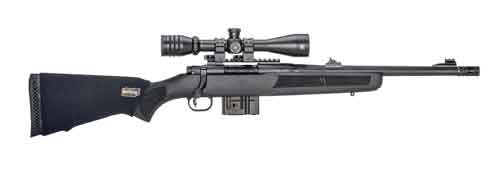 came standard with a 3-9X tactical scope already mounted. And scopes are an option with any of the MVP rifles. Another option on this particular model is the choice of a plain muzzle or one that is threaded with a flash suppressor attached. The stock on the MVP Patrol is black synthetic and the rifle weighs 8 lbs.
came standard with a 3-9X tactical scope already mounted. And scopes are an option with any of the MVP rifles. Another option on this particular model is the choice of a plain muzzle or one that is threaded with a flash suppressor attached. The stock on the MVP Patrol is black synthetic and the rifle weighs 8 lbs.
Yet another variation of the Mossberg MVP rifles is the Thunder Ranch model, which is available only in 5.56 mm. An OD green synthetic stock is complemented by an 18.5" fluted, medium bull barrel. The rifle has a Picatinny rail for optics and no iron sights. Weight runs slightly more than 8 lbs.
And the Mossberg MVP series continues to grow. Mossberg has announced that it will soon offer rifles designed in cooperation with Red Jacket Firearms. These are the folks on the “Sons of Guns” show on the Discovery Channel. And you can bet that one of the Mossberg/Red Jacket guns will be an MVP.
My own evaluation of the Mossberg MVP rifles began with a Newfoundland moose hunt with Mt. Peyton Outfitters, out of Bishops Falls, Newfoundland. For this hunt I chose to shoot the MVP Predator, in 7.62 mm NATO, with the 18.5" fluted, medium bull barrel and laminated wood stock. Since some of my luggage was lost in aeronautical oblivion, I had to borrow a 3-9X scope and some ammunition from the guides and other hunters. But we got the rifle outfitted and headed off into the rainy woodlands.
When we made contact with a bull moose, my guide and I were standing in the timber next to a marshy meadow. The guide was doing his best to imitate a cow call and, while I was impressed, I didn’t know how impressed a bull moose would be. Verification came when a young bull began to answer the call from off to my left and slightly behind us. When the bull came into view, it was just about 15 yds. away.
My first shot took the bull on the point of the right shoulder as it spun to its left and galloped out into the meadow. Running the bolt, I hit the moose with another shot in the short ribs on the right side, with the bullet angling forward through the body. He dropped about 30 yds. from us and was done.
Now game shots at this sort of close range don’t tell us much about rifle accuracy. But it says a lot about how quick and handy a rifle can be. To make matters worse, I was shooting this right-handed rifle from my left shoulder, which can make a quick, follow-up shot a bit of a problem. The smooth action of the Mossberg MVP proved itself to me that afternoon.
Interestingly, Mossberg’s choice of calibers just about covers the gamut of hunting in North America. The .204 Ruger cartridge does a great job on varmints and small game. The 5.56 mm (.223 Rem.) has proven itself on varmints, small game, and even medium-sized game animals, such as whitetail deer (where allowed by law, of course). With the 7.62 mm (.308 Win.) the shooter is capable of taking all North American animals and most African animals, with the exception of dangerous game. All of which assumes, of course, proper bullet selection, good shot placement and an accurate rifle.
Following the Newfoundland moose hunt, Mossberg shipped me an MVP Patrol in 7.62 mm for further testing and evaluation. The black synthetic stock is of classic configuration and the shorter, 13.25" length-of-pull makes it handy for tactical applications. The matte-black finish of the barrel and action reduce reflection and add to the business-like appearance of the rifle. Mossberg’s engineers cleverly designed the 7.62 mm series rifles to accept either M110/SR-25-pattern or M14-type magazines interchangeably, which makes finding spares much easier.
As with the MVP Predator, I found that the bolt ran smoothly even when running it hard for fast follow-up shots. Magazines were easy and quick to insert, with the magazine release being located in the bottom of the rifle stock, just in front of the magazine well. The magazine seats with a positive audible and tactile snap.
Running action drills with the MVP Patrol, I found that the rifle comes to the shoulder quickly. The stock design is such that my eye was aligned with the scope as soon as the rifle came to rest. And, again, the smooth action and good trigger system made quick shots, and quick follow-up shots, relatively easy. Stock design and the good recoil pad made the recoil of the .308 Win. cartridge quite manageable.
Accuracy testing was done from sandbag rests on 100-yd. targets. And, frankly, it was much better than what I expected from a rifle with a 16.25" barrel. The combination of Mossberg’s adjustable trigger system, the UTC 3-9X tactical scope (a Mossberg option), and medium bull barrel, delivers the kind of accuracy that will protect the home or put venison on the table. It is a good example of the utility rifle concept.
Of course, only time will tell how well a particular rifle holds up to use and abuse in the field. However, I purposely did not pamper either of the MVP rifles that I used. Both fired and functioned reliably, and I suspect that the MVP system is rugged enough to give the shooter years of good service.
The major criticism that I have of the MVP series is that the stocks are unnecessarily thick. In the area of the action, the rifle has to have a certain thickness to accommodate the 7.62 mm magazines. However, the fore-end of the stock seems clubby and doesn’t accommodate small hands very well. I would suggest that Mossberg consider tapering the stock from in front of the stock screw to the tip. This would produce better handling qualities, reduce the weight just a bit, and lend a more pleasing appearance to the rifle. And, of course, we left-handed shooters would certainly appreciate a left-handed version of the MVP, especially in the Patrol model.
The concept of a multi-purpose rifle is as important today as it has ever been in our history. Whether you call them scout rifles, truck guns or utility rifles, they have an application for law enforcement and for the armed citizen who hunts and also recognizes that he may need to protect himself and his family.
The biggest feather-in-the-cap for Mossberg is that it did not come up with just one rifle design and expect its customers to become accustomed to it.
Instead it has designed a family of rifles that allows the shooter to pick the model and caliber that most closely fits his or her particular situation and needs. It’s a rather democratic approach to rifle building, if you will.
Technical Specifications
Manufacturer: O.F. Mossberg & Sons, Inc., 7 Grasso Avenue, North Haven, CT 06473; (203) 230-5500; mossberg.com
Caliber: 7.62x51 mm NATO (.308 Win.)( tested); 5.56x45 mm NATO (.223 Rem.)
Action Type: bolt-action, center-fire, repeating rifle
Receiver: matte-black carbon steel
Barrel: 161⁄4" medium bull barrel, threaded, flash suppressor
Rifling: six-groove, 1:10" RH twist
Magazine: 10-round detachable box
Sights: adjustable rear; fiber-optic front
Trigger: Lightning Bolt Action adjustable trigger system; single stage, 3-lb., 2-oz. pull
Stock: Black synthetic: length of pull: 13¼"; drop at comb, 1¼"; drop at heel, 1"
Overall Length: 37½"
Weight: 8 lbs.
Accessories: Picatinny rail, lock, neoprene comb raising kit, 3-9X scope
Suggested Retail Price: $863












